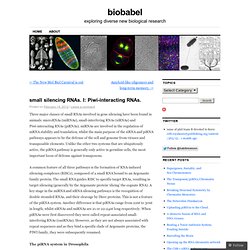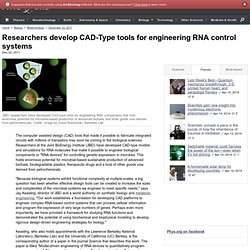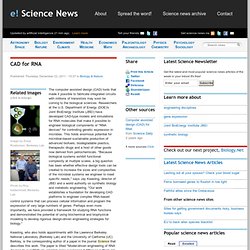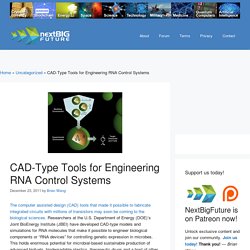

Detecting Gene Doping in Sports: MicroRNA biomarker sought. The World Anti-Doping Agency (WADA) has committed $50 million US dollars to research since 2001 (see their grant applications & projects here).

Since 2007, some of those research funds have gone to the emerging problem of gene doping. Read about the first public evidence of gene doping, from the trial of the German track coach Thomas Springstein., in the NYT article Outlaw DNA. So what is gene doping? WADA defines it as “the transfer of nucleic acids or nucleic acid sequences’ and/or ‘the use of normal or genetically modified cells with the intention to enhance sports performance.” Gene doping is based on a vector containing a therapeutic gene coupled with a regulatory element, delivered to somatic cells either in, or ex vivo.
Outlaw DNA - New York Times. Enabling RNA therapy. Scientists Discover New Clue To The Chemical Origins Of Life. What mysterious genetic material ruled the world before DNA and RNA? Exploring diverse new biological research. Small silencing RNAs. I: Piwi-interacting RNAs. Three major classes of small RNAs involved in gene silencing have been found in animals: microRNAs (miRNAs), small-interfering RNAs (siRNAs) and Piwi-interacting RNAs (piRNAs). miRNAs are involved in the regulation of mRNA stability and translation, whilst the main purpose of the siRNA and piRNA pathways appears to be the defense of the cell and genome from viruses and transposable elements.

Unlike the other two systems that are ubiquitously active, the piRNA pathway is generally only active in germline cells, the most important locus of defense against transposons. LincRNAs in development and evolution. RNAi and Chromatin Modification. RNAi silences genes by targeting mRNAs for degradation.

However, a second mode by which RNAi effects gene silencing has emerged: by triggering chromatin modifications. Gu et al have analysed the pattern of a specific chromatin modification in response to exogenous double stranded RNA (dsRNA) in C. elegans and show that RNAi triggered chromatin modification is target gene specific and transgenerationally heritable. The ability of exogenous dsRNAs to silence homologous target genes (RNA interference, RNAi) was discovered in the nematode worm, C. elegans, approximately fifteen years ago. Feeding worms bacteria expressing dsRNA, or bathing worms in dsRNA, has the ability to specifically block gene function and most surprisingly this effect in C. elegans is inherited for some generations. RNAi has become an incredibly useful technique in biology as it works to a greater or lesser extent throughout eukarya, and offers a simple and fast method for compromising gene action specifically.
RNomics' Posterous - RNA, evolution, origin of life, genomics, drug discovery, etc. RNOMICS. Built-in 'self-destruct timer' causes ultimate death of messenger RNA in cells. Researchers at Albert Einstein College of Medicine of Yeshiva University have discovered the first known mechanism by which cells control the survival of messenger RNA (mRNA) -- arguably biology's most important molecule.

The findings pertain to mRNAs that help regulate cell division and could therefore have implications for reversing cancer's out-of-control cell division. The research is described in today's online edition of the journal Cell. "The fate of the mRNA molecules we studied resembles a Greek tragedy," said the study's senior author, Robert Singer, Ph.D., co-director of the Gruss Lipper Biophotonics Center and professor and co-chair of anatomy and structural biology at Einstein.
"Their lifespans are determined at the moment of their birth. " The study was carried out in yeast cells using advanced microscope technology developed previously by Dr. Researchers develop CAD-Type tools for engineering RNA control systems. The computer assisted design (CAD) tools that made it possible to fabricate integrated circuits with millions of transistors may soon be coming to the biological sciences.

Researchers at the Joint BioEnergy Institute (JBEI) have developed CAD-type models and simulations for RNA molecules that make it possible to engineer biological components or "RNA devices" for controlling genetic expression in microbes. This holds enormous potential for microbial-based sustainable production of advanced biofuels, biodegradable plastics, therapeutic drugs and a host of other goods now derived from petrochemicals.
"Because biological systems exhibit functional complexity at multiple scales, a big question has been whether effective design tools can be created to increase the sizes and complexities of the microbial systems we engineer to meet specific needs," says Jay Keasling, director of JBEI and a world authority on synthetic biology and metabolic engineering. CAD for RNA. Related images(click to enlarge) Image by Zosia Rostomian, Berkeley Lab Photo by Roy Kaltschmidt, Berkeley Lab The computer assisted design (CAD) tools that made it possible to fabricate integrated circuits with millions of transistors may soon be coming to the biological sciences.

Researchers at the U.S. CAD-Type Tools for Engineering RNA Control Systems. JBEI researchers have developed CAD-type tools for engineering RNA components that hold enormous potential for microbial-based production of advanced biofuels and other goods now derived from petrochemicals.

(Image by Zosia Rostomian, Berkeley Lab) “Because biological systems exhibit functional complexity at multiple scales, a big question has been whether effective design tools can be created to increase the sizes and complexities of the microbial systems we engineer to meet specific needs,” says Jay Keasling, director of JBEI and a world authority on synthetic biology and metabolic engineering. Transposome-based RNA-Seq library construction from low input amounts of RNA. A collaborative effort between Epicentre and the HudsonAlpha Institute for Biotechnology resulted in the development of two novel transposon-based methods for RNA-Seq library preparation.

The technique, called Tn-RNA-Seq, can use double-stranded cDNA created from rRNA-depleted RNA to prepare an Illumina® sequencing library using only two enzymatic reactions. The researchers generated high-quality RNA-Seq libraries from as little as 10 pg of mRNA (~1 ng of total RNA) with this approach. They also present a strand-specific RNA-Seq library construction protocol that combines transposon-based library construction with uracil DNA glycosylase and Endonuclease VIII to specifically degrade the second strand constructed during cDNA synthesis.
These directional RNA-Seq libraries maintained the same quality as the nondirectional libraries, while showing a high degree of strand specificity (99.5% of reads mapped to the expected genomic strand). 2011 UGA Conference on Drug Discovery: anti-HIV RNAs, enhanced DNA vaccines, and adenosine ligands « Antiviral Immunity. The real highlight of the 2011 UGA Conference on Drug Discovery (sponsored by the University of Georgia Center for Drug Discovery) was the food.

After all the free soda, scones, biscuits, fried chicken and rice, strawberry shortcake, malt balls, and gummy worms, I feel a little sick to my stomach. In addition to all the good food, there were some good talks, including “Small RNAs: their biology and therapeutic applications in HIV and cancer” by John Rossi, PhD, “Synthetic DNA vaccines for treatment or prophylaxis of difficult pathogens” by David Weiner, PhD, and “Drug discovery based on G protein-coupled receptors for extracellular nucleosides and nucleotides” by Kenneth Jacobson, PhD. These talks are summarized below. The fundamental role of RNA editing. The genome is a plastic thing. Yes, that's right: the genome is plastic. No, it's not true that an individual's DNA doesn't change.
It's not true that genes dictate what we are, and it's not true that DNA is just a set of instructions. And that we can "build" an organism by simply giving a string of As, Gs, Ts, and Cs. No. There's so much more to genomes than nucleotides and genes. Seq Blog. Computer simulation of evolution of primordial molecular machine. As a molecular machine found in all living cells that is of central importance for the synthesis of the proteins upon which all life depends, the ribosome is perhaps the primordial example of a molecular machine.

For this reason, a recent Open Access publication in the Journal of Molecular Modeling is of substantial interest to those wishing to understand how molecular machines could evolve to execute complex functions. “An information-carrying and knowledge-producing molecular machine. A Monte-Carlo simulation” presents a computer simulation of how, by a long sequence of chemical steps, a simple self-replicating oligomer in a specific environment could evolve into a machine to translate a genetic code into amino acid sequences. [Be sure to download the supplemental material as well as the main text because the supplemental figures make it much easier to follow the author's argument.]